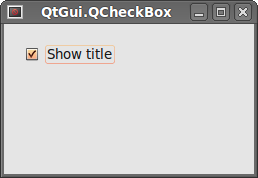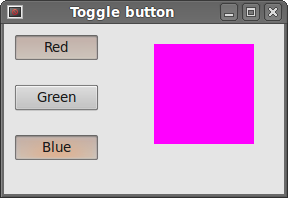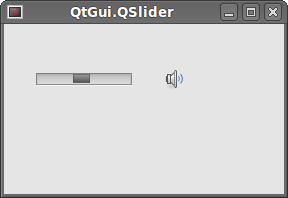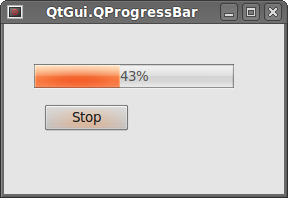PyQt4 Widgets
Widgets are basic building blocks of an application. The PyQt4 programming toolkit has a wide range of various widgets. Buttons, check boxes, sliders, list boxes etc. Everything a programmer needs for his job. In this section of the tutorial, we will describe several useful widgets. NamelyQtGui.QCheckBox, ToggleButton, QtGui.QSlider, QtGui.QProgressBar and a QtGui.QCalendarWidget.QtGui.QCheckBox
QtGui.QCheckBox is a widget that has two states. On and Off. It is a box with a label. Checkboxes are typically used to represent features in an application that can be enabled or disabled without affecting others. #!/usr/bin/pythonIn our example, we will create a checkbox that will toggle the window title.
# -*- coding: utf-8 -*-
"""
ZetCode PyQt4 tutorial
In this example, a QtGui.QCheckBox widget
is used to toggle the title of a window.
author: Jan Bodnar
website: zetcode.com
last edited: September 2011
"""
import sys
from PyQt4 import QtGui, QtCore
class Example(QtGui.QWidget):
def __init__(self):
super(Example, self).__init__()
self.initUI()
def initUI(self):
cb = QtGui.QCheckBox('Show title', self)
cb.move(20, 20)
cb.toggle()
cb.stateChanged.connect(self.changeTitle)
self.setGeometry(300, 300, 250, 150)
self.setWindowTitle('QtGui.QCheckBox')
self.show()
def changeTitle(self, state):
if state == QtCore.Qt.Checked:
self.setWindowTitle('QtGui.QCheckBox')
else:
self.setWindowTitle('')
def main():
app = QtGui.QApplication(sys.argv)
ex = Example()
sys.exit(app.exec_())
if __name__ == '__main__':
main()
cb = QtGui.QCheckBox('Show title', self)
This is the QtGui.QCheckBox constructor. cb.toggle()We set the window title, so we must also check the checkbox. By default, the window title is not set and the checkbox is unchecked.
cb.stateChanged.connect(self.changeTitle)We connect the user defined
changeTitle() method to the stateChanged signal. The changeTitle() method will toggle the window title. 
Figure: QtGui.QCheckBox
ToggleButton
PyQt4 has no widget for a ToggleButton. To create a ToggleButton, we use aQtGui.QPushButton in a special mode. ToggleButton is a button that has two states. Pressed and not pressed. You toggle between these two states by clicking on it. There are situations where this functionality fits well. #!/usr/bin/pythonIn our example, we create three ToggleButtons. We also create a
# -*- coding: utf-8 -*-
"""
ZetCode PyQt4 tutorial
In this example, we create three toggle buttons.
They will control the background color of a
QtGui.QFrame.
author: Jan Bodnar
website: zetcode.com
last edited: September 2011
"""
import sys
from PyQt4 import QtGui
class Example(QtGui.QWidget):
def __init__(self):
super(Example, self).__init__()
self.initUI()
def initUI(self):
self.col = QtGui.QColor(0, 0, 0)
redb = QtGui.QPushButton('Red', self)
redb.setCheckable(True)
redb.move(10, 10)
redb.clicked[bool].connect(self.setColor)
redb = QtGui.QPushButton('Green', self)
redb.setCheckable(True)
redb.move(10, 60)
redb.clicked[bool].connect(self.setColor)
blueb = QtGui.QPushButton('Blue', self)
blueb.setCheckable(True)
blueb.move(10, 110)
blueb.clicked[bool].connect(self.setColor)
self.square = QtGui.QFrame(self)
self.square.setGeometry(150, 20, 100, 100)
self.square.setStyleSheet("QWidget { background-color: %s }" %
self.col.name())
self.setGeometry(300, 300, 280, 170)
self.setWindowTitle('Toggle button')
self.show()
def setColor(self, pressed):
source = self.sender()
if pressed:
val = 255
else: val = 0
if source.text() == "Red":
self.col.setRed(val)
elif source.text() == "Green":
self.col.setGreen(val)
else:
self.col.setBlue(val)
self.square.setStyleSheet("QFrame { background-color: %s }" %
self.col.name())
def main():
app = QtGui.QApplication(sys.argv)
ex = Example()
sys.exit(app.exec_())
if __name__ == '__main__':
main()
QtGui.QWidget. We set the background color of the QtGui.QWidget to black. The togglebuttons will toggle the red, green and blue parts of the color value. The background color will depend on which togglebuttons we have pressed. self.col = QtGui.QColor(0, 0, 0)This is the initial color value. It is black.
redb = QtGui.QPushButton('Red', self)
redb.setCheckable(True)
redb.move(10, 10)
To create a ToggleButton, we create a QtGui.QPushButton and make it checkable by calling setCheckable() method. redb.clicked[bool].connect(self.setColor)We connect a
clicked signal to our user defined method. source = self.sender()We get the button, which was toggled.
if source.text() == "Red":In case it was a red button, we update the red part of the color accordingly.
self.col.setRed(val)
self.square.setStyleSheet("QFrame { background-color: %s }" %
self.col.name())
To change the background color, we use stylesheets. 
Figure: ToggleButton
QtGui.QSlider
QtGui.QSlider is a widget that has a simple handle. This handle can be pulled back and forth. This way we are choosing a value for a specific task. Sometimes using a slider is more natural, than simply providing a number or using a spin box. QtGui.QLabel displays text or image. In our example we will show one slider and one label. This time, the label will display an image. The slider will control the label.
#!/usr/bin/pythonIn our example we simulate a volume control. By dragging the handle of a slider, we change a image on the label.
# -*- coding: utf-8 -*-
"""
ZetCode PyQt4 tutorial
This example shows a QtGui.QSlider widget.
author: Jan Bodnar
website: zetcode.com
last edited: September 2011
"""
import sys
from PyQt4 import QtGui, QtCore
class Example(QtGui.QWidget):
def __init__(self):
super(Example, self).__init__()
self.initUI()
def initUI(self):
sld = QtGui.QSlider(QtCore.Qt.Horizontal, self)
sld.setFocusPolicy(QtCore.Qt.NoFocus)
sld.setGeometry(30, 40, 100, 30)
sld.valueChanged[int].connect(self.changeValue)
self.label = QtGui.QLabel(self)
self.label.setPixmap(QtGui.QPixmap('mute.png'))
self.label.setGeometry(160, 40, 80, 30)
self.setGeometry(300, 300, 280, 170)
self.setWindowTitle('QtGui.QSlider')
self.show()
def changeValue(self, value):
if value == 0:
self.label.setPixmap(QtGui.QPixmap('mute.png'))
elif value > 0 and value <= 30:
self.label.setPixmap(QtGui.QPixmap('min.png'))
elif value > 30 and value < 80:
self.label.setPixmap(QtGui.QPixmap('med.png'))
else:
self.label.setPixmap(QtGui.QPixmap('max.png'))
def main():
app = QtGui.QApplication(sys.argv)
ex = Example()
sys.exit(app.exec_())
if __name__ == '__main__':
main()
sld = QtGui.QSlider(QtCore.Qt.Horizontal, self)Here we create a horizontal
QtGui.QSlider. self.label = QtGui.QLabel(self)We create a
self.label.setPixmap(QtGui.QPixmap('mute.png'))
QtGui.QLabel widget. And set an initial mute image to it. sld.valueChanged[int].connect(self.changeValue)We connect the
valueChanged signal to the user defined changeValue() method. if value == 0:Based on the value of the slider, we set an image to the label. In the above code, we set a mute.png image to the label, if the slider is equal to zero.
self.label.setPixmap(QtGui.QPixmap('mute.png'))
...

Figure: QtGui.QSlider widget
QtGui.QProgressBar
A progress bar is a widget that is used, when we process lengthy tasks. It is animated so that the user knows, that our task is progressing. TheQtGui.QProgressBar widget provides a horizontal or vertical progress bar in PyQt4 toolkit. The task is divided into steps. The programmer can set the minimum and maximum values for the progress bar. The default values are 0, 99. #!/usr/bin/pythonIn our example we have a horizontal progress bar and a push button. The push button starts and stops the progress bar.
# -*- coding: utf-8 -*-
"""
ZetCode PyQt4 tutorial
This example shows a QtGui.QProgressBar widget.
author: Jan Bodnar
website: zetcode.com
last edited: September 2011
"""
import sys
from PyQt4 import QtGui, QtCore
class Example(QtGui.QWidget):
def __init__(self):
super(Example, self).__init__()
self.initUI()
def initUI(self):
self.pbar = QtGui.QProgressBar(self)
self.pbar.setGeometry(30, 40, 200, 25)
self.btn = QtGui.QPushButton('Start', self)
self.btn.move(40, 80)
self.btn.clicked.connect(self.doAction)
self.timer = QtCore.QBasicTimer()
self.step = 0
self.setGeometry(300, 300, 280, 170)
self.setWindowTitle('QtGui.QProgressBar')
self.show()
def timerEvent(self, e):
if self.step >= 100:
self.timer.stop()
self.btn.setText('Finished')
return
self.step = self.step + 1
self.pbar.setValue(self.step)
def doAction(self):
if self.timer.isActive():
self.timer.stop()
self.btn.setText('Start')
else:
self.timer.start(100, self)
self.btn.setText('Stop')
def main():
app = QtGui.QApplication(sys.argv)
ex = Example()
sys.exit(app.exec_())
if __name__ == '__main__':
main()
self.pbar = QtGui.QProgressBar(self)This is a
QtGui.QProgressBar constructor. self.timer = QtCore.QBasicTimer()To activate the progress bar, we use the timer object.
self.timer.start(100, self)To launch the timer events, we call the
start() method. This method has two parameters. The timeout and the object, which will receive the events. def timerEvent(self, e):Each
if self.step >= 100:
self.timer.stop()
self.btn.setText('Finished')
return
self.step = self.step + 1
self.pbar.setValue(self.step)
QtCore.QObject and its descendants has a timerEvent()event handler. In order to react to timer events, we reimplement the event handler. def doAction(self):Inside the
if self.timer.isActive():
self.timer.stop()
self.btn.setText('Start')
else:
self.timer.start(100, self)
self.btn.setText('Stop')
doAction() method, we start and stop the timer. 
Figure: QtGui.QProgressBar
QtGui.QCalendarWidget
TheQtGui.QCalendarWidget provides a monthly based calendar widget. It allows a user to select a date in a simple and intuitive way. #!/usr/bin/pythonThe example has a calendar widget and a label widget. The currently selected date is displayed in the label widget.
# -*- coding: utf-8 -*-
"""
ZetCode PyQt4 tutorial
This example shows a QtGui.QCalendarWidget widget.
author: Jan Bodnar
website: zetcode.com
last edited: September 2011
"""
import sys
from PyQt4 import QtGui, QtCore
class Example(QtGui.QWidget):
def __init__(self):
super(Example, self).__init__()
self.initUI()
def initUI(self):
cal = QtGui.QCalendarWidget(self)
cal.setGridVisible(True)
cal.move(20, 20)
cal.clicked[QtCore.QDate].connect(self.showDate)
self.lbl = QtGui.QLabel(self)
date = cal.selectedDate()
self.lbl.setText(date.toString())
self.lbl.move(130, 260)
self.setGeometry(300, 300, 350, 300)
self.setWindowTitle('Calendar')
self.show()
def showDate(self, date):
self.lbl.setText(date.toString())
def main():
app = QtGui.QApplication(sys.argv)
ex = Example()
sys.exit(app.exec_())
if __name__ == '__main__':
main()
cal = QtGui.QCalendarWidget(self)We construct a calendar widget.
cal.clicked[QtCore.QDate].connect(self.showDate)If we select a date from the widget, a
clicked[QtCore.QDate] signal is emitted. We connect this signal to the user defined showDate() method. def showDate(self, date):We retrieve the selected date calling the
self.lbl.setText(date.toString())
selectedDate() method. Then we transform the date object into string and set it to the label widget. 
Figure: QtGui.QCalendarWidget
In this part of the PyQt4 tutorial, we covered several widgets.
No comments:
Post a Comment